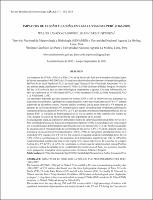Impacts of El Niño and La Niña in the precipitation over Perú (1965-2007)
Fecha
2014-06Colecciones
- Artículo científico [171]
Resumen
The impacts of El Niño (EN) and La Niña (LN) in rainfall in Peru are evaluated using monthly data (1965-2007) of 155 stations distributed over the three hydrographic drainages of Peru: 85 in the Pacific (VP), 21 in the Lake Titicaca (VT) and 49 in the Amazon (VA). To classify El Niño and La Niña is used the Index Troup Southern Oscillation (SOI) based on hydrological years (September to August). Using these values was reclassified as strong El Niño (ENF) moderate El Niño (ENM), moderate La Niña (LNM) and strong La Niña (LNF). The results show that only during ENF and LNF events exhibit a high percentage of stations with significant anomalies of precipitation and mainly located in the VP and VT during the December to May period. Our analysis confirms that the northern part of the VP has an increased rainfall during ENF, while the southern Andean region of the VP has decreased (increased) rainfall during ENF (LNF). The VT presents a significant rainfall deficit during ENF. The precipitation variation in the VA is instead more sensitive to LNF events, during which major rainfall are observed than usually. In a second step, we analyze the main modes of interannual variability of rainfall in Peru using the technique of empirical orthogonal functions (EOF). The results are related to the variability of sea surface temperature and IOS, E and C indices of the equatorial Pacific. It was found that the main mode of rainfall variability (PC1, 37% of the total variance) is associated with two extraordinary events EN (1983 and 1998), which generated heavy rain in the north of the VP and droughts in the VT and VA. On the other hand, the second mode of variability of rainfall (PC2, 25%) correlates with anomalies of sea surface temperature in the central equatorial Pacific, cold conditions in this region (LN) causes more rainfall than normal in the Andean region of the VP, VT and in VA. In conclusion, it appears that the variability of the Pacific Ocean not explain the entire rainfall variability in Peru. Thus, perspectives are described considering other regions such as the Tropical Atlantic Ocean.
El ítem tiene asociados los siguientes ficheros de licencia:








